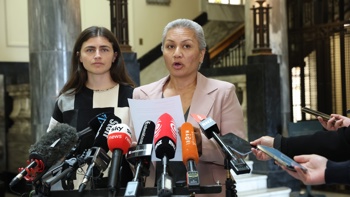Prime Minister Jacinda Ardern says a tough new quarantine for all Kiwis arriving from overseas will kick in from midnight tonight and will continue indefinitely.
"No-one goes home, everyone goes into a managed facility," she said of Kiwis returning to the country.
She revealed the much-anticipated measure at a press conference today where 29 new cases of Covid-19 since yesterday were announced - the lowest number since March 21.
The new cases are made up of 23 new confirmed cases and six new probable cases.
There are now 317 recovered cases – an increase of 35 on yesterday, higher than the number of new cases. Fourteen people are in hospital and four in ICU.
The combined total of confirmed and probable cases in New Zealand is 1239.
Director-General of Health Ashley Bloomfield said it was hard to predict the future, but today was the fourth consecutive day when the number of new cases decreased and that was encouraging.
Ardern said Cabinet will make a decision on a possible move out of alert level 4 on April 20 - two days before it is due to be lifted.
"That's because we need to use the most up to date data that we have to make that decision.
"As we head into Easter, I say thank you to you and your bubble. You have stayed calm, you've been strong, you've saved lives, and now we need to keep going."
She said that border controls, more testing, and contact-tracing were key factors moving forward.
PM reveals quarantine for international arrivals
On day 15 of the lockdown, Ardern told Kiwis that it was working and announced a blanket quarantine of people arriving from overseas.
She said from midnight tonight every New Zealander boarding a flight to return home will be required to undergo quarantine or managed isolation in an approved facility for a minimum of 14 days.
Those with symptoms will be in quarantine and will not be allowed to leave the hotel room, but those in managed isolation will be able to get some fresh air.
Police will monitor the facilities, she said. The military could also be used for quarantine enforcement.
Ardern said there was no endpoint for the border controls, as borders will continue to be a high-risk of importing a Covid-19 case.
They could be in place until a vaccine is ready, which has been estimated as 12 to 18 months away.
"Even one person slipping through the cracks and bringing the virus in can see an explosion in cases, as we have observed with some of our bigger clusters," Ardern said.
"A network of up to 18 hotels will be used to implement this approach, of which one to two will be specifically set aside for those under strict quarantine conditions."
Campervans will also be used for quarantine, should they be needed.
Ardern said the cost of the quarantine policy was being negotiated, but she would seek "best value" for taxpayers.
She defended not moving to a blanket quarantine sooner, saying the sheer volume of numbers was too great to be feasible.
"Nearly 40,000 New Zealanders have returned home since the 20th of March, when we closed the border to foreign nationals. That is more than all of the hotel rooms across the country that we could have properly housed people in."
But the number of overseas arrivals has not topped 300 for a week.
Ardern said another reason not to impose a blanket quarantine sooner was because of the prospect of extra arrivals, for instance for travellers transiting through New Zealand - which has recently been allowed under strict health conditions.
Contact-tracing tech
Contact-tracing would also be enhanced by technology, Ardern said.
"The Ministry of Health is already working on a locally-developed app that will assist with contact-tracing."
She said the Government was looking at the Singaporean Government's Bluetooth-based app TraceTogether, which relies on voluntary uptake.
"I have a phone call with Prime Minister Lee of Singapore this evening where I will be discussing this technology further."
But she said an app with high uptake didn't need to ready before the lockdown could be lifted.
Infectious diseases specialist Dr Ayesha Verrall has called for capacity to trace the close contacts of 1000 cases a day - or up to 7000 close contacts a day.
That is 10 times the current capacity.
But Bloomfield said capacity didn't need to be so high before lockdown could be eased, noting that there are fewer than 1000 active cases ( confirmed cases minus recovered cases) now.
Ardern also cited the need to continue a high rate of testing.
"With these three pillars, border controls, rigorous testing and contact tracing, we have what we need to win this marathon."
'You have saved lives'
Halfway through the lockdown, Ardern said that Kiwis had saved lives.
"What New Zealanders have done over the last two weeks is huge. In the face of the greatest threat to human health we have seen in over a century, Kiwis have quietly and collectively implemented a nationwide wall of defence," she said.
"We are on track to meet their most optimistic scenario. We are turning a corner. But to succeed, we need it to keep working.
"This is going to be a marathon."
She said to expect roadblocks this Easter weekend.
"While most people are doing the right thing, some are not. We cannot let the selfish actions of a few set us back."
She repeated the modelling that showed that New Zealand was on a similar trajectory to Italy and Spain, and that the 205 cases on the 25th of March could have grown to over 10,000 by now.
New modelling due to be released later today by Te Punaha Matatini suggests that the current lockdown has had a significant impact.
She said she was acutely aware of the sacrifices that New Zealanders were going through.
"I have read messages from those who have lost loved ones they couldn't come together to grieve for, brand new parents whose most joyful time has been made so difficult because of separation.
"Businesses who are worried for their livelihoods and for the family that are their employees."
Over a million were now being supported by the Government wage subsidy, while an extra 4866 Kiwis were on a benefit.
Asked about the passing of Te Huirangi Waikerepuru, Ardern said there would be a time and a place for when people will be able to gather to grieve.
But many of the existing clusters had come from social occasions and it was important to ban congregations for now for public health reasons.
Details on the lift to alert level 3 to be provided next week
She said next week she would outline what life would look like at alert level 3, and a decision would be made on lifting the lockdown on April 20.
"If we are ready to move to alert level 3, business we will have two days to implement arrangements.
"But let me say again, we will not be moving out of level 4 early. If we move to early, we will go backwards."
Businesses should start thinking about how they can have physical distancing, whether they need personal protective equipment, and how they can contact trace customers.
There had been no decision yet whether Parliament could sit under alert level 3, she said.
Different alert levels might apply to different educational levels such as ECE, and there would be more detail next week.
She said it would not be life as it used to be when the lockdown was eventually lifted.
Asked about the election, Ardern said the current plan was to hold it on September 19, but it would continue to be reviewed.
"It is too soon to make a determination of where we will be, even in a month's time from now."
Update on 12 big clusters
The proportion of today's cases linked to overseas travel is 41 per cent, while 44 per cent are linked to confirmed cases within New Zealand and 2 per cent are linked to community transmission; 13 per cent are still being investigated.
There are still 12 significant clusters, the largest of which are Matamata (64); Bluff (87); and Marist College (84),
Bloomfield said it was important to ring-fence the clusters as quickly as possible, and being in lockdown had helped.
"We are confident we are on top of those clusters."
The seven-day rolling average of tests is at 3547 per day, and the total number is 51,165 tests.
Take your Radio, Podcasts and Music with you









